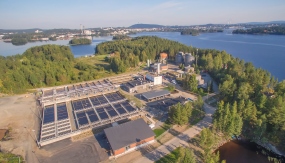
City of Kuopio Lehtoniemi waste water treatment plant © Aleksi Rajala
Kuopio has realized something very important about life. This is reflected in the unhurried lifestyle and the favorable winds helping people along in work, business and studies. The local outlook on life permeates every aspect of living in Kuopio- from the vibrant nightlife to the comfort of the home. In Kuopio, inspiration, caring and the freedom of simply being are forces of nature that grow into unique success stories and phenomena.
What has already been done in Kuopio to promote the circular economy?
Kuopio's new climate program was completed in autumn 2020. According to the program, the city aims to be carbon neutral in 2030. At the beginning of 2021, the city of Kuopio switched to using only green electricity. The city's total electricity consumption is about 55,000 MWh per year, and with the use of green electricity, the city will reduce its CO2 emissions by about 13.7 million kilos.
In Kuopio, organic waste is treated at the Gasum biorefinery, which produces fertilizers for agriculture and biogas for energy production and in the future for transport distribution as well. Biogas is also utilized at Lehtoniemi wastewater treatment plant, owned by the local water treatment company Kuopion Vesi. The plant utilizes process heat in the treatment plant's buildings and produces biogas from the treatment plant sludge for energy production. The plant is nearly energy self-sufficient.
Circular economy and resource efficiency show in the construction of schools of Kuopio. The von Wright School, which was finished in 2021, is built from wood, it is heated by geothermal energy and it has solar panels on its roof. The school’s carbon footprint is about 44 % smaller than a concrete-structured school of the same size using district heating. Jynkä School, on the other hand, is a modifiable, resource efficient, multi-purpose community building that combines school, library and recreational facilities. The heat is produced by geothermal and district heating. In addition, the demolition material of the previous school building was utilized in the structures of the yard area.
The Savilahti area will be transformed into an energy-efficient and climate-friendly new city district. In the summer of 2020, a new district cooling plant began operations. The plant uses cold water in the nearby Neulalahti basin. District cooling saves up to 80% of electricity compared to cooling produced by property-specific cooling equipment.
Goals as a pioneering municipality
We are initiating new projects to promote the circular economy with a variety of operators. In addition to this, we are working to increase awareness of the circular economy through a variety of communication campaigns. The goal is to ensure that as many of the local residents, housing companies, business owners, employees and managers as possible know what the circular economy means in the context of their actual daily lives.
More information